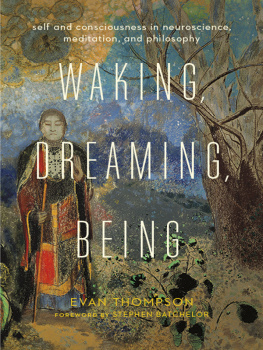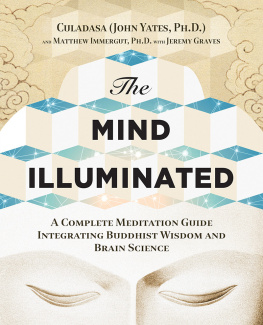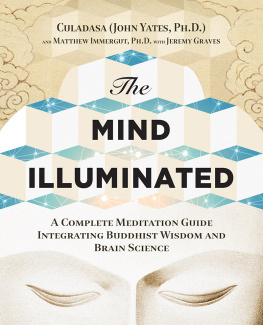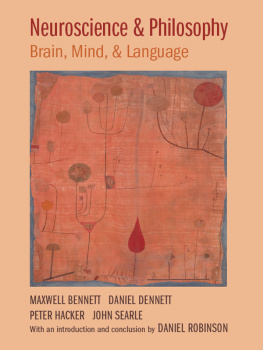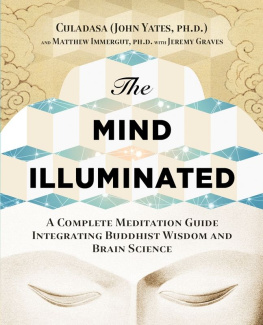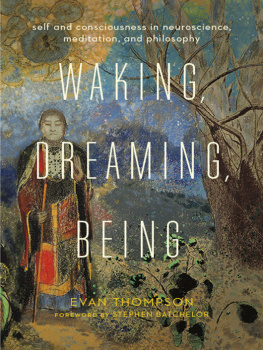WAKING,
DREAMING,
BEING
WAKING,
DREAMING,
BEING
self and consciousness in neuroscience, meditation, and philosophy
EVAN THOMPSON
COLUMBIA UNIVERSITY PRESS
NEW YORK
Columbia University Press
Publishers Since 1893
New York Chichester, West Sussex
cup.columbia.edu
Copyright 2015 Evan Thompson
All rights reserved
E-ISBN 978-0-231-53831-2
Library of Congress Cataloging-in-Publication Data
Thompson, Evan.
Waking, dreaming, being : new light on the self and consciousness from neuroscience, meditation, and philosophy / Evan Thompson.
pages cm
Includes bibliographical references and index.
ISBN 978-0-231-13709-6 (cloth : alk. paper)
ISBN 978-0-231-53831-2 (electronic)
1. Consciousness. 2. Self. I. Title.
B808.9T456 2015
128'.2dc23
2014004887
A Columbia University Press E-book.
CUP would be pleased to hear about your reading experience with this e-book at .
Cover design: Alex Camlin
Cover image: The Buddha, c.1905 (pastel on paper), Redon, Odilon (18401916) / Muse dOrsay, Paris, France / Giraudon / Bridgeman Images Book design: Lisa Hamm
References to websites (URLs) were accurate at the time of writing. Neither the author nor Columbia University Press is responsible for URLs that may have expired or changed since the manuscript was prepared.
For my mother and father:
Gail Gordon Thompson and William Irwin Thompson
Someone who dreams of drinking wine at a cheerful banquet may wake up crying the next morning. Someone who dreams of crying may go off the next morning to enjoy the sport of the hunt. When we are in the midst of a dream, we do not know its a dream. Sometimes we may even try to interpret our dreams while we are dreaming, but then we awake and realize it was a dream. Only after one is greatly awakened does one realize that it was all a great dream, while the fool thinks that he is awake and presumptuously aware.
Chuang Tzu (Zhuang Zi), trans. Victor H. Mair,
Wandering on the Way: Early Taoist Tales and Parables of Chuang Tzu
CONTENTS
by Stephen Batchelor
W ere you to ask someone today what comes to mind on hearing the word meditation, I suspect that they would immediately think of a person sitting cross-legged on a cushion with her eyes closed. If you then asked: Do you meditate? they would likely take this as a question about whether they regularly practice a spiritual exercise, probably derived from an Asian religion. Yet such usage of the term meditation in the West is relatively recent. A hundred years ago, the word would rarely have been used this way. To say you were meditating would have meant that you were considering something thoughtfully (according to Chambers), a definition that now strikes us as odd or archaic. Few today would find the seventeenth-century poet John Miltons line And strictly meditate the thankless Muse comprehensible at all.
This is but one example of how non-Western ideas have slowly infiltrated our ways of thinking and speaking. Such shifting use of language forms part of a complex historical and cultural process that began with the first translations of classical Asian texts at the end of the eighteenth century. Interest in Eastern ideas has waxed and waned over the decades since, but during the past fifty years or solargely triggered by the countercultural movements of the 1960sit seems to have increased exponentially. While it may have taken more than a century for meditation to have acquired its current usage, it seems to have taken only ten or fifteen years for the word mindfulness to have gained a similar currency in English.
When I lived as a Buddhist monk in the Tibetan community around the Dalai Lama in Dharamsala during the early 1970s, if someone had suggested that by 2013 mindfulness meditation would be freely available through the British National Health Service and that a U.S. congressman would have published a book called A Mindful Nation, I would have dismissed that person as a fantasist. Yet this is exactly what has happened. A term that was once used in its current sense only by a small number of Buddhist meditators has now spread virally into popular discourse.
The medical professionals who use mindfulness-based therapies have (or should have) no interest in promoting Buddhism. They have adopted the practice of mindfulness solely because clinical trials have shown that it is an effective treatment for certain pathological conditions such as relapse into depression. Yet this raises a crucial question: if one of its central practices can be shown to work in a nonreligious, secular setting, should we continue to regard Buddhism as a religion? According to the earliest canonical texts, Siddhattha Gotama presented his teachings as practical exercises that would lead to palpable and predictable results. Although the Buddhas teachings have given rise over the centuries to faith-based institutions and dogmas that we would unhesitatingly call religious, might such developments be a digression from or even a betrayal of the founders original intentions?
We need, therefore, to distinguish between Buddhism as a belief-based religion and Buddhism as a pragmatic philosophy with ethical and contemplative practices. Yet it is not so easy to know where to draw the line. Among contemporary Buddhists, opinions vary as to whether reincarnation, for example, should be treated as an empirical fact that will one day be confirmed by scientific evidence, or as merely an artifact of prescientific Indian cosmology. Some argue that Buddhism without reincarnation is unintelligible; others insist that the doctrine of reincarnation obscures the Buddhas primary concerns and should be discarded.
Evan Thompson refuses to take an a priori stand on such issues. He seeks instead to keep an open mind with regard to the metaphysical claims of traditional Buddhist, Hindu, and Taoist teachings, while at the same time subjecting them to a critique based on the findings of science. Likewise, he acknowledges the limitations of the scientific method in coming to terms with the felt reality of first-person experience, which involves what it is like to be a self endowed with consciousness. He thus envisages a synthesis of objective scientific rigor coupled with first-hand reports of contemplative experience. Moreover, although trained in the discipline of Western philosophy, he draws on the rich philosophical thought of India and China, thus building a way to a collaboration of ideas that is still resisted in the Eurocentric culture of the Western academy.
I first encountered the work of Evan Thompson in the early 1990s when I came across

